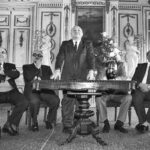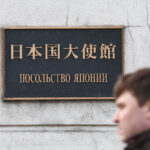The “Active Citizen” portal has started voting for architectural projects that could be implemented on the site of the former Council for Mutual Economic Assistance (CMEA) building on New Arbat.
The city government has invited residents to choose from three concepts:
1) The building retains the familiar “book” appearance and is supplemented with an extension resembling a “huge scroll,” symbolizing “knowledge, traditions, and preserved memory”;
2) Three high-rise buildings will be constructed on the site, with their lines and forms echoing the historical appearance of the original structure;
3) The old building will be renovated, and another “book-shaped” structure, larger in size, will be built next to it.
The city government noted that a team of Russian and international specialists, designers, and urban planners will work on the architectural projects. All presented concepts aim to create a “new cluster rooted in historical traditions,” as stated in the press release on the Moscow government’s website.
The decision to construct the CMEA building was made by the organization’s executive committee in September 1962. The project was developed by architects Mikhail Posokhin, Ashot Mndoyants, and Vladimir Svirsky. Construction lasted from 1963 to 1970. The complex included three buildings—a 31-story administrative tower, a conference center, and a standalone hotel called “Mir.” They covered 4.5 hectares and were united by a common stylobate.
In 1991, after the dissolution of the CMEA, its property, including a motor pool, printing house, and the “Druzhba” resort in the Naro-Fominsk district of the Moscow region, was transferred to the Moscow city government. For over 30 years, the building housed various city government offices. In November 2023, the “Book House” was donated by Olimp JSC and became the property of Moscow.
Council for Mutual Economic Assistance (CMEA) building
The **Council for Mutual Economic Assistance (CMEA) building**, located in Moscow, was the headquarters of the CMEA (Comecon), an economic organization of socialist states (1949–1991) led by the Soviet Union. Designed by Soviet architects, the modernist high-rise, completed in 1969, symbolized Eastern Bloc cooperation during the Cold War. After the USSR’s collapse, it became the Moscow City Hall and later housed Russian government offices.
New Arbat
New Arbat (Novy Arbat) is a major avenue in Moscow, Russia, constructed in the 1960s as part of a Soviet urban renewal project. Known for its striking high-rise buildings and modernist architecture, it contrasts with the historic Old Arbat street nearby. Today, it is a bustling commercial and entertainment hub, featuring shops, restaurants, and offices.
Mir
The Mir Castle Complex, located in Belarus, is a stunning example of 16th-century fortification architecture, blending Gothic, Baroque, and Renaissance styles. Built by Duke Ilinich in the early 1500s, it later passed to the Radziwiłł family and endured significant damage during the Napoleonic Wars and World War II. Restored in the 20th century, it was designated a UNESCO World Heritage Site in 2000 for its historical and cultural significance.
Druzhba
“Druzhba” (Дружба) is a common place name in Slavic countries, meaning “Friendship,” often used for parks, cultural centers, or monuments symbolizing unity. One notable example is the *Druzhba (Friendship) Monument* in Bulgaria, built in 1985 near Varna to commemorate 1,300 years of Bulgarian-Russian relations. Another is *Druzhba Narodiv Park* in Kyiv, Ukraine, created in the Soviet era to celebrate international solidarity among socialist nations. These sites reflect historical ties and ideological themes of cooperation.
Naro-Fominsk district
The Naro-Fominsk district is a historic area located in the Moscow Oblast of Russia, known for its significant role during World War II, particularly in the Battle of Moscow (1941–1942). The region features memorials and museums dedicated to the war, alongside picturesque landscapes and cultural heritage sites. Today, it serves as both a residential and recreational area, blending historical importance with natural beauty.
Book House
The **Book House** is a charming independent bookstore known for its cozy atmosphere and curated selection of books, often specializing in rare, used, or niche titles. While its specific history may vary by location, many such bookshops have served as cultural hubs for literary communities, preserving the tradition of physical bookstores in the digital age. Some may have historical significance if housed in a heritage building or tied to local literary movements.
Olimp JSC
“Olimp JSC” is a Russian company primarily known for producing betting and gambling products, including sports betting and lottery services. Founded in 1992, it became one of the leading betting operators in Russia, offering both online and offline betting options. The company has faced regulatory changes over the years, particularly with Russia’s evolving gambling laws, but remains a significant player in the industry.
Moscow government
The Moscow government oversees the administration of Russia’s capital and largest city, operating from historical buildings such as the Moscow City Hall (Tverskaya Street 13), which dates back to the 18th century. As a political and cultural hub, Moscow has been a center of Russian governance for centuries, from the Tsardom of Muscovy to the modern Russian Federation. The city’s government manages infrastructure, public services, and urban development while preserving Moscow’s rich historical heritage.



